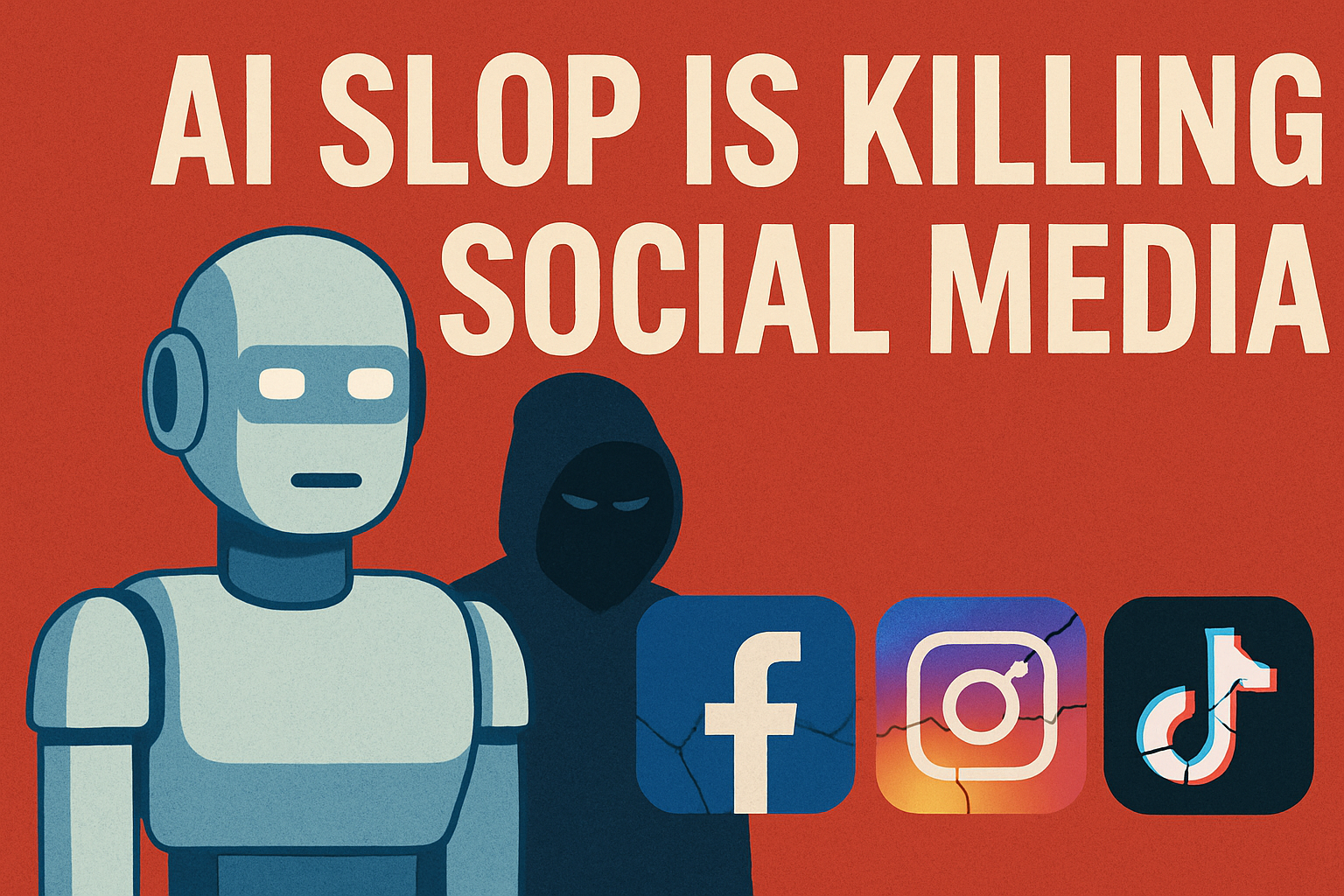The internet as we knew it is dying, and faceless AI-generated accounts are the culprits. What started as platforms designed to bring people together has devolved into a wasteland of soulless content farms, all chasing the same monetisation dream that’s turned our favourite social spaces into barely usable digital junkyards.
The Invasion is Everywhere
YouTube has become particularly painful to watch. My son gravitates towards these channels with their grating, obviously artificial voiceovers; they’re so easy to spot once you know what to look for. But it’s not just YouTube. Pinterest has descended into complete chaos, with AI-generated content flooding every category. The user base has essentially declared war on the platform over how poorly they’re handling AI content moderation. The irony is thick: Pinterest’s own AI systems, designed to flag questionable content for copyright issues, are now penalising users who’ve innocently pinned this AI-generated garbage from faceless channels to their boards.
X (formerly Twitter) has been wrestling with this problem for ages, whilst I can’t speak to the current state of Facebook or TikTok because I abandoned those platforms long before AI generation became widespread. The user-generated rubbish was already unbearable enough.
Even my Instagram feed, which I check sporadically, is now drowning in AI-generated nonsense. What’s worse, friends have started sharing this content in our private group chats, seemingly unaware of what they’re spreading.
How We Got Here
Remember Web 2.0? That optimistic era was all about building genuine communities where people could connect and share meaningful content. Platforms like Facebook, Instagram, Twitter, YouTube, and Pinterest emerged from this vision, creating spaces for authentic human interaction.
But somewhere along the way, these platforms became business plays. The focus shifted from community building to user retention, all in service of attracting advertisers willing to pay for eyeballs. When influencer marketing entered the scene and certain users became powerful voices for product promotion, content became a commodity. This monetisation opportunity attracted the faceless channel brigade like moths to a flame.
AI has supercharged this problem by making content generation ridiculously cheap and easy. Now these faceless accounts are so pervasive across all platforms that many have become virtually unusable.
The Platform Death Spiral: Medium’s Cautionary Tale
Medium provides the perfect cautionary tale of how AI content can destroy a platform. The writing platform became overwhelmed with AI-generated articles specifically targeting its Partner Program monetisation system. AI-generated articles are diluting Medium’s Partner Program, siphoning earnings and frustrating genuine writers, with many legitimate creators reporting their earnings being cannibalised by low-quality, machine-generated content.
The platform had to implement strict policies prohibiting AI content monetisation entirely, essentially admitting that their revenue-sharing model had become a magnet for content farms. Writers who had invested years building their Medium presence found themselves competing against an endless stream of AI-generated articles designed purely to extract money from the partner program.
What made Medium’s situation particularly damaging was how their discovery algorithm amplified AI content. The platform’s engagement-based monetisation model meant that any content generating clicks and reads would earn money, regardless of quality or authenticity. This created a race to the bottom, where human writers struggled to compete with AI systems that could pump out dozens of articles daily, all optimised for Medium’s engagement metrics rather than genuine value.
Substack: Doing It Differently
Whilst Medium struggled with AI content farms gaming its system, Substack has emerged as a compelling counterpoint that demonstrates how different monetisation models can solve these problems. Rather than competing for shared advertising revenue or algorithm-driven discovery, Substack’s model is fundamentally different: writers build direct relationships with subscribers who pay them directly.
Substack makes money by charging 10% transaction fees on all paid subscriptions, but crucially, writers own their subscriber lists and set their own prices. This creates a completely different incentive structure. Instead of churning out content to game an algorithm, writers must create genuine value for people willing to pay for their work. AI content farms can’t easily exploit this model because it requires building trust and delivering consistent value to real people who’ve chosen to subscribe.
The platform focuses on direct communication between creators and readers, prioritising one-to-one interactions rather than viral distribution. Writers can mix free content to attract readers with paid content to monetise their work, and they maintain complete control over their subscriber relationships. Unlike Medium’s algorithm-dependent discovery system, Substack success depends on genuine audience building rather than platform gaming.
This model has proven remarkably resistant to AI spam because there’s no easy way to monetise without delivering real value. You can’t simply flood the platform with AI-generated content and expect to earn money; you need subscribers who actively choose to pay for your work. It’s a return to the fundamental principle that good content should be rewarded by people who value it, rather than by manipulating platform metrics.
Where Do We Go From Here?
The contrast between Medium’s struggles and Substack’s success illustrates exactly what’s wrong with current social media platforms. The fundamental problem is the incentive structure. When platforms reward content creation through advertising revenue sharing or algorithm-driven monetisation, they inevitably attract bad actors more interested in gaming the system than contributing anything meaningful. Substack’s subscription model sidesteps this entirely by making the audience, not the platform, the ultimate arbiter of value.
The system feels fundamentally broken, and I suspect people will eventually abandon these platforms en masse in search of alternatives. But what might those alternatives look like, and crucially, how do we keep the AI slop out?
I envision a new breed of platforms emerging, designed exclusively for genuine user-generated or brand-generated content. The key challenge is keeping faceless channels at bay, and the solution might be radical: complete demonetisation.
The Path Forward: Learning from Substack
What if we created platforms where users and brands could share content and promote themselves, but without any third-party monetisation opportunities? By removing the financial incentive that attracts content farms, we could potentially exclude the junk currently poisoning our feeds.
Substack has already proven this approach works for written content. The key insight is that sustainable content platforms need direct relationships between creators and consumers, rather than intermediary monetisation systems that can be gamed. These platforms would need to be sustainable through other means; perhaps subscription models like Substack’s, one-time fees, or alternative revenue streams that don’t reward bulk content creation. The focus would return to quality over quantity, genuine connection over engagement farming.
The question isn’t whether this change will come, but when. The current trajectory is unsustainable, and users are growing increasingly frustrated with the artificial wasteland that social media has become. The platforms that recognise this shift early and build genuinely human-centred alternatives will likely capture the audience fleeing the AI-infested incumbents.
The internet was built for human connection. It’s time we reclaimed it.







Leave a Reply